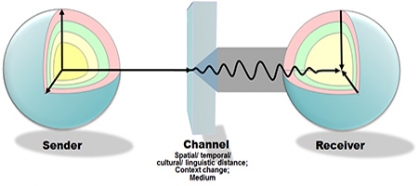Communication model
The following communication model is based on the classical Shannon-Weaver model. It describes the information flow from sender to receiver. The message is coded by the sender, transferred by a medium and eventually decoded by receivers. Disruption can occur everywhere, i.e. during the coding, transmission and the decoding. Examples of communication disruptions are meaning falsification (e.g. generalization, elimination, distortion, ambiguity, and metaphors), language difficulties, transmission distortion, and distorted perception and interpretation problems.

The memecon communication model extends the classical model with the steps of meaning design on sender and receiver side.
Sender
Senders develop ideas and send formulated concepts to receivers. The core of a message is the idea that wants to be transmitted. After ideas are collected, topics are identified that will be prepared as concepts. The final, consistent concept is formulated, prepared and transmitted receiver-oriented.
Channel
The channel is the medium that is used to transfer the message, e.g. air, paper, internet. During this transmission spatial, temporal, cultural and linguistic distances need to be compensated. This context change leads to distortions and losses of meaning, e.g. in the case of the translation not all aspects can be transferred exactly.
Receiver
Receivers perceive the message with their senses (vakog, i.e. visual, auditory, kinesthetic, olfactory, and gustatory) and associate the individual understanding. Selected senses are addressed depending on the formatting by the sender, e.g. through mainly visualization („A Picture says more than thousand Words “). With the sensuous perception receivers take over control of the meaning. Based on their knowledge and experience receivers associate contents and develop a positive or negative core message for themselves that motivates to act or not.
During the communication the participants change permanently between the roles of sender and receiver. Eventually based on the exchange of contents the common understanding emerges and additionally individual interpretations that are not transferred. 100% common understanding is impossible. However it is essential: The bigger the shared interpretation, the better the co-operation.
